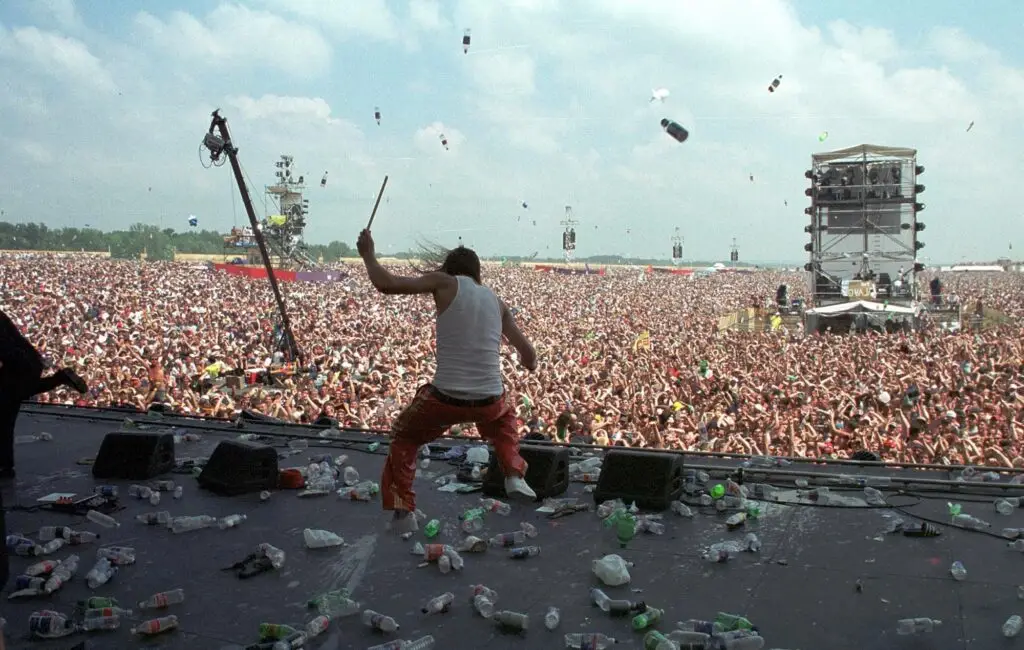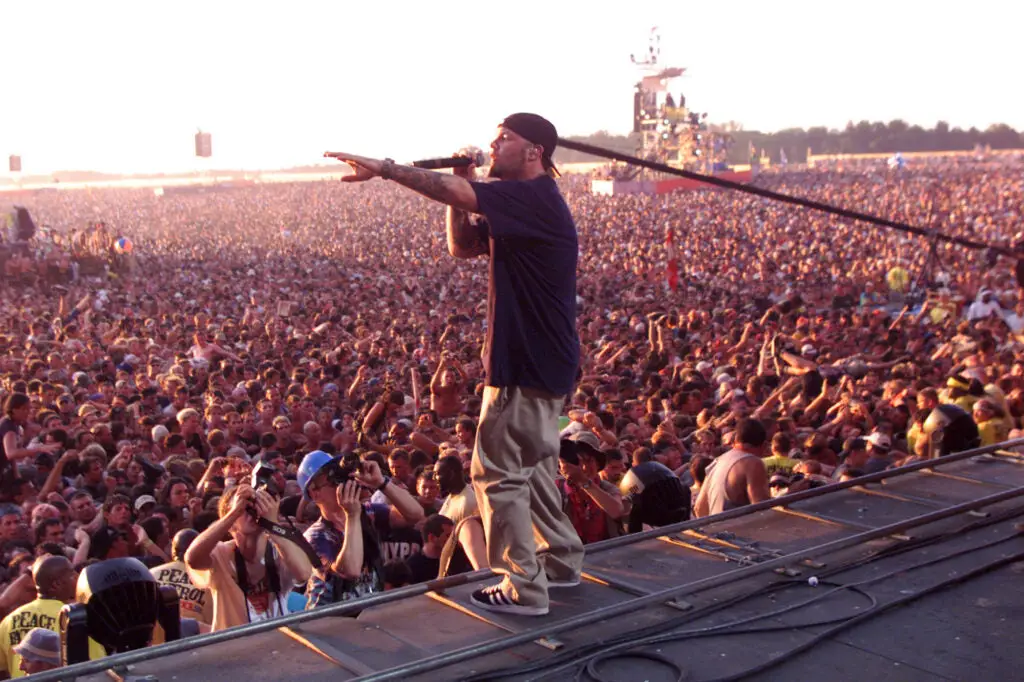At the beginning of Woodstock 99: Peace, Love, and Rage, the first in a series of music documentaries from HBO, it’s mentioned how a movie detailing the infamously destructive festival could easily seem like a comedy at first. And perhaps the film’s closest comparison would be Netflix’s Fyre: The Greatest Party That Never Happened, but the level of the insanity of Woodstock ‘99 makes it much more akin to that of a horror movie.
Now, if for some reason you’re here on Knotfest.com and aren’t familiar with the four-day music festival that held famous performances from artists like Korn, Metallica, Limp Bizkit, Rage Against the Machine, Megadeth, Red Hot Chili Peppers, and a wide variety of others like Wyclef Jean, Ice Cube, Elvis Costello, Sheryl Crow, DMX, Willie Nelson, and Dave Matthews Band, then buckle up. It was a doozy.
Woodstock ‘99 took place on a particular warm weekend in July in upstate New York and played host to nearly half a million people. Directed by Garret Price, who previously made the film Love, Antosha which chronicled the life of young actor Anton Yelchin, the documentary shows the immediate issues that the festival was faced with. First off, the event was held at a former Air Force base, with very little shade to deal with the soaring temperatures and nothing but asphalt and black tarmac between the two main stages, which were nearly a mile apart. Many attendees faced heat-related health issues such as dehydration - naturally, there was a severe lack of access to clean drinking water - and were forced to take cover underneath trucks and buses.

The sheer number of people makes it difficult to enforce security and maintain facilities in working order - difficult, but not impossible. Yet there was an inadequate amount of staff hired for an event of that size, and security in particular faced issues such as improper training and many of the hirees simply abandoning their posts as the festival got underway and eventually out of control. Any sort of sanitation quickly became nonexistent, with the porta potties being rendered inoperable by the first day, overturned, and...well, the details are pretty gross, to say the least. Large swaths of people became lost and separated from their groups with no easy way to find each other or even get their bearings in the massive sea of bodies (this was before cell phones, after all). Fires were set, walls and audio towers were destroyed, and general mayhem ensued throughout the weekend.
But the film’s most shocking and psetting factors that it zeroes in on are the grotesque acts of mass sexual assault that occured on the site. Many of the women and young girls present at the concert were molested, attacked, and even raped. It’s the final nail in the coffin for showing how Woodstock ‘99 was largely a preventable tragedy - one EMT that’s interviewed describes how despite working multiple major hurricanes, he still considers the festival to be the largest disaster he’s ever been at.
Peace, Love, and Rage captures the looming sense of dread that the festival seemed to carry with it from its onset, creating the feeling of a powder keg about to go off. The sweltering heat might as well be a character all its own. Timestamps that appear on screen alongside whichever artist was performing at the time have a strange sense of malice about them. Certain ones, like when the film finally arrives at Saturday’s notorious Limp Bizkit set, almost make you hold your breath for what’s about to come.
What’s most fascinating about the documentary is just how in-depth it goes, presenting a number of unexpected factors from culture, history, and statistics that it argues were major contributors to everything that went down. The directionless fury of the generation still reeling from the death of Kurt Cobain and the corporate perversion of once-hallowed bastions like MTV seemed to come to a head that weekend, alongside the general air of misogyny and objectification of women that plagued the nation in the aftermath of the Bill Clinton scandal and the height of things like Girls Gone Wild.

And while acts like Limp Bizkit truthfully attract a wide variety of people from around the world (and thankfully, the film doesn’t seem too interested in placing blame on the artists) the only audience that this iteration of Woodstock seemed interested in was white men of the worst kind; the kind of obnoxious frat boys that ruin everything for everyone. Even so, Price’s documentary appears to emphasize that the true brunt of the blame for the festival’s various problems rests on the greed and apathy of the people who put it together in the first place. Attendees weren’t allowed to bring in their own food or water, and bottles of water (which, you know, people need to live, especially when it’s hot out) were relatively pricey. As one interviewed survivor puts it, “When the price of the water is the same as the price of the beer, there’s a problem.”
The most revealing sections of the film feature the daily press conferences that took place during the festival, where the promoters uncaringly shut down all of the journalists' questions and concerns about what they’ve been witnessing. The biggest perpetrator of the chaos seems to be promoter John Scher, who reveals himself to still be arrogant, refusing fault for everything that went wrong, and unsympathetic towards everyone who was harmed at the event he was responsible for in the film’s modern day interview with him.
Peace, Love, and Rage is an engrossing look at one of the most pivotal cultural events that occurred at the turn of the century, all of the good, the bad, the very bad, and the weird of it. Nothing seems quite as poignant as the footage of guys tearing down the festival’s “peace wall” that featured lovingly painted murals - a sad reminder that you can’t force things like unity, peace and love, and cynically doing so only leads to disaster.
'Woodstock 99: Peace, Love, and Rage' is now streaming on HBO Max.




